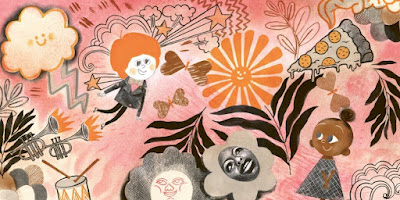Written by Michelle Kadarusman
Illustrated by Maggie Zeng
Pajama Press
978-1-77278-252-3
32 pp.
Ages 5-8
June 2022
With fire season upon us, Room for More reminds us of the fragility of habitats and the vulnerability of animals to destruction too often wrought by humans, whether by carelessness or climate change. Fortunately, animal species such as the Australian ones Michelle Kadarusman has highlighted here do better than we do at showing compassion, generosity, flexibility and reciprocity.
 |
From Room for More by Michelle Kadarusman, illus. by Maggie Zeng
|
Two wombats, Dig and Scratch, know that when they smell the smoke of a bushfire that they will be safe in their deep burrows. But when they hear other animals scurrying for safety outside, Dig offers them shelter, though Scratch keeps reiterating that, "
There is no room." Still, Dig tells a wallaby with a joey in her pouch who was already succumbing to the smoke that, "
We have plenty of room."
 |
| From Room for More by Michelle Kadarusman, illus. by Maggie Zeng |
When Dig spots a koala clinging to a tree, he again helps a stranded animal, against Scratch's grumblings of limited space. When a tiger snake is spotted, there is much trepidation about a venomous snake that might bite but Dig is convinced the snake will behave.
 |
| From Room for More by Michelle Kadarusman, illus. by Maggie Zeng |
Though very snug in the wombats' burrow, the motley group of animals survive until a rain comes and puts out the bushfire. But, with that rain, comes a new worry for the wombats whose home is in danger of flooding. However, their new friends find a way to reciprocate the relief provided, showing a generosity of spirit all around.
Australian-born author Michelle Kadarusman's "Author's Note" reveals that Room for More is based on the science that animals other than wombats would find safety in their deep burrows during the horrific bushfires of 2019-2020. Perhaps there weren't discussions between wombats about helping out or animals uniting to engineer an embankment, but Michelle Kadarusman reminds us that all animals, even unlikely allies, can cooperate for greater good and without compulsion for mutual benefit, though in this case that is exactly what happens. Though the consequences of bushfires are often devastating, Michelle Kadarusman has emphasized a gentler story, that of animals surviving and by unusual means. And that's the good story. But Michelle Kadarusman also gives us the science of Room for More, providing a glossary of the species involved in the story as well as explaining important issues like climate change, environmental disasters and Australian Indigenous land practices.
 |
From Room for More by Michelle Kadarusman, illus. by Maggie Zeng
|
That gentle touch to what is a heartbreaking and devastating circumstance is emulated in artist Maggie Zeng's digital illustrations. While there is an orange hue of fires and a pall of grey haze to the landscape, Maggie Zeng does not overwhelm the art with angry flames or blackened scenes of destruction. Instead, she takes us to a dry and warm setting that is softened with the kindness of benevolence. In her colours and shapes, Maggie Zeng offers generosity and compassion.
I know teachers will love to share this story with their students whether for STEM lessons regarding habitat, characteristics of living things, different world biomes or climate change or for character education centered on empathy and goodwill but at its heart it is a sweet story that goes beyond teaching by captivating readers and transporting them to other worlds. It would seem there's always room for another fabulous picture book on the youngCanLit shelves.







































